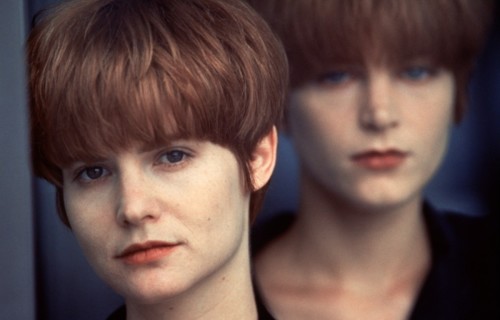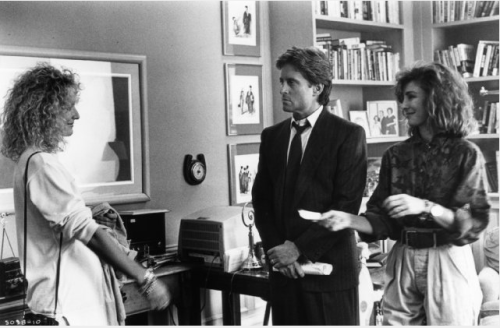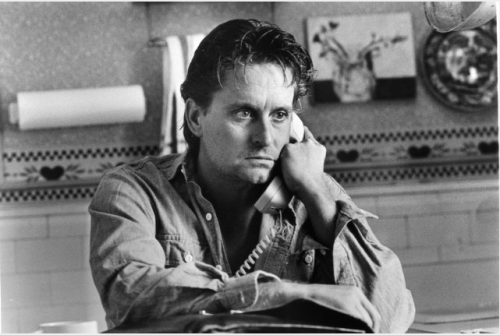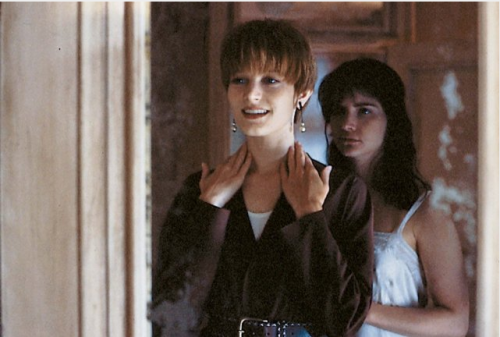This is a guest post by Stephanie Brown.
“‘I won’t be ignored, Dan.'”
As a new friend and I got to know each other during the past couple of years, this became our shorthand joke. We’d say it when we worried we were calling or texting too often. We used that line because the character Alex Forrest, who says the line (actually “I’m not going to be ignored, Dan!”) in the film Fatal Attraction is the symbol for a person who doesn’t take a hint, let alone an outright declaration that a person doesn’t want an involvement. She’s a person who becomes a stalker because she’s delusions about her relationship with a married man. She becomes as destructive and vengeful as a witch in a fairy tale.
No one wants to be the person who has no common sense about other people. No one wants to be Alex Forrest, or Hedra “Hedy” Carlson in Single White Female, another film that gave us a character so needy and envious, she puts Snow White’s stepmother to shame. When someone “goes all Single White Female” on you, you know you’re dealing with someone who can suck the life out of you by copying your moves and destroying you in the process. Viewers, like the victims who surround an evil witch in a fairy tale, learn that it’s almost impossible to outwit these two, as their nasty feelings manifest into destructive actions, but outwit them we must.
Both films are misogynistic. They depict women we hate and would hate to be like. If we knew more about them we’d probably feel compassion for what made them so evil–but like figures in fairy tales, the backstory is irrelevant to the action and to the victims facing their wrath. Alex and Hedy are symbols for those hatable people who are normal-on-the-surface-but-
I saw Fatal Attraction by myself when I was living by myself, an SFW (single white female, in the shorthand of classified seeking-roommate ads of the day) in Oakland, Calif. The theater was packed and the audience’s shout-outs to the screen funny and raucous as Alex’s behavior became increasingly bizarre.
By the climax–where she is shot in the bathtub by the wife, Beth Gallagher–I was laughing out loud. The movie seemed ludicrous to me. Soon after seeing it, I tuned into the end of a radio show. The person speaking was animated about her subject, the movie Fatal Attraction, which she said was a hot conversation topic between men and women because the story reflected anxieties about feminism and working women. To me it seemed to be a cautionary tale for men about how the wages of sin (adultery) can lead them to ruin, but it was hard for me to believe that a person like Alex could even exist. But then, I lived alone (and was lonely) and had no one to really talk to about the movie, whether it was ludicrous or should be taken seriously, or about feminism or anything else.
What I did know about living alone was that it might make you go crazy. You forget how much you have been with your own thoughts when you finally talk to someone. Not having a romantic partner made me unhappy and disappointed with life, which are probably the feelings Alex and Hedy had, being alone in the world, looking for a connection. Why they did not have connections is only hinted at, and we can only guess why. I was in my 20s when I saw these films, the time of life when most people have temporary living arrangements, like the characters in Single White Female. I had lived in five different places by the time I was 26. You took chances on roommates and places and living alone in safe or unsafe neighborhoods. I had lived anonymously in two large cities. Like city dwellers Dan and Allie, in a city one has to take a person at her word when looking for a living arrangement or when meeting in the workplace. You don’t have a small town’s generational history to inform you that someone has been damaged by their childhood or was outcast by everyone. That’s also the reason why the city appeals to people–it’s a place to reinvent oneself, where no one really knows you, and where most relationships are friendly but safely superficial. This is the same in the large workplace, where one can observe another’s eccentric or charming or moody behavior at a distance. You only know what someone is really like by working closely with them. It’s amazing how personality deficits and disorders are revealed when one is in daily contact with someone else in the workplace. In all cases, your relationships are left mostly to chance.
At that time I still kept in touch with childhood friends and still felt close to them. Though we only saw each other a few times a year, we talked on the phone for hours sometimes, at long-distance expense, which I budgeted for; it felt so necessary to me. However, every time we got together I could feel us drifting apart.
The friend I was closest to called me soon after Fatal Attraction was released, and asked me what I thought of it. It had really struck a chord with her. She saw it by herself and then took her boyfriend to see it, because she wanted him to see her resemblance to Alex; she thought it would help him understand her better. In particular, the scene where Alex sits alone in her apartment and turns the light on and off is what she wanted him to see. She wanted him to understand how she felt–I suppose how she felt when she felt desperate? They were not in a cheating relationship and were not married, but she related to the character’s personality. I don’t remember if I told her this, but I found that very disturbing. I could not imagine relating to Alex at all, and I still don’t. Had I not known her for as long as I had, I would have dropped the friendship then and there. As it was, our friendship did not last and for me is was because of coming behaviors that did indeed evoke Alex’s. I also knew by that time that I ought not to live alone with few connections. It might make me into an Alex or a Hedy. I also knew that I had the capacity to be like Allie or Dan, using people and expecting them to not care, and I knew I had experienced envy from others, and I did not like how it felt.
These films were released within a few years of each other: Fatal Attraction in 1987, Single White Female in 1992. They are sometimes seen as mirrors of the era, especially as responses to ascending feminism. But to me, feminism had already ascended and was accepted–I suppose I was naive, but to me they were about women with damaged psyches whose gigantic wells of neediness and envy were so mythic they created tragedies because they did not know how to do anything else. In the 30 years or so since these films were released, I’ve come to know many women like both of these women–not that they’ve come to bloody conclusions, but they have created nightmares, migraines and heart attacks, for instance, as well as fear and anxiety and frustration. I wish we had had the characters’ back stories in the films. In the years since, I’ve become fascinated by what breaks people and makes them behave in such ways. I have learned compassion for them while still keeping them at arms’ length. The stories’ plots, however, depend upon us identifying with Dan in Fatal Attraction and Allie in Single White Female. It is possible to find yourself at a point in life where you must obtain a restraining order against someone. At that point, it is not hard to identify with these victims.
People like Alex and Hedy are people who feel dead and empty and hopeless; they can’t be helped, they push too hard, they want the impossible and don’t give up when they should. Someone who seems fun and lovely at first but who is impossible once the mask is taken off her face. We saw a few glimpses of Alex’s scrapbook in the film, but were not given enough to speculate about her background or what made her the way she was. We don’t know why they lack connections with others.
But maybe that is beside the point: the Alexes and Hedys I’ve known have few connections because everyone has left them behind and wants nothing to do with them. No one can stand them for very long. It’s hard to believe, because when you meet them, they are friendly and fun and have good heads on their shoulders. But after a while the mask slips and one finds oneself growing annoyed at giving the same advice to their requests for advice, or hearing the same complaints about the same person again and again, or finding out something that makes the hair stand up at the back of your neck: that the person was let go from a job because, you’re now told, the principal of the school did not understand how to discipline kids properly, the way she did. When your work acquaintance becomes your boss and you discover she yells and screams until you feel like you are living with an abusive mother in a tiny house where you are never fed or looked after, you know why she has gotten stuck at this particular rung in their career, and why you are likely to pass her as she drifts downward. People like her fake it by using buzzwords and speaking aggressively and sounding smart, while there is no substance to back it up. To mask their incompetence, they need to steal your ideas, block your ideas, exhaust your ears, or take on your mannerisms and demeanor because they see how others have a positive response.
Fairytales tell us how to make practical choices when faced with another’s envy or wrath. Children are instructed on what to do when faced with Snow White’s envy (leave home) or Cinderella’s sisters (wait it out–they will destroy themselves) or how to fell a jealous father-giant (be clever and nimble and you will cut him down eventually). There are people who wish us ill and mean us harm. There are people so envious and angry of those around them (usually those who are competent, gifted or kindhearted) that their satisfaction comes from seeing the envied fail and flail. As Jeanette Winterson wrote of her mother in Why Be Happy When You Could Be Normal, a book that uses fairytales tropes as a way to understand a destructive, cold mother: “She filled the phone box. She was out of scale, larger than life. She was like a fairy story where size is approximate and unstable. She loomed up. She expanded. Only later, much later, too late, did I understand how small she was to herself.” [1]
When we’ve escaped from an Alex or Hedy, we can look back and see how someone who destroys others is sad or desperate or lonely or feels small. I think Winterson is right–destructive women loom large, change size, extend themselves by loud voice, by taking things from you, by holding weapons because they feel small and overlooked. Though we might sympathize, mostly we reflect on them, after escaping them, with awe and terror. They are not good. They are not our lovers nor our friends; they do not have our best interests at heart.
Because I’ve known them, I value my new friend all the more, the one with whom I can use a shorthand joke from Fatal Attraction. She also has known these kinds of people, who actually may be men or women.
1. Jeanette Winterson, Why Be Happy When You Could Be Normal?, p. 2-3. New York: Knopf, 2011.
Stephanie Brown is the author of two collections of poetry, Domestic Interior and Allegory of the Supermarket. She’s published work in American Poetry Review, Ploughshares, and The Best American Poetry series. She was awarded an NEA Fellowship in 2001 and a Breadloaf Fellowship in 2009. She has taught at UC Irvine and the University of Redlands and is a regional branch manager for OC Public Libraries in southern California.








